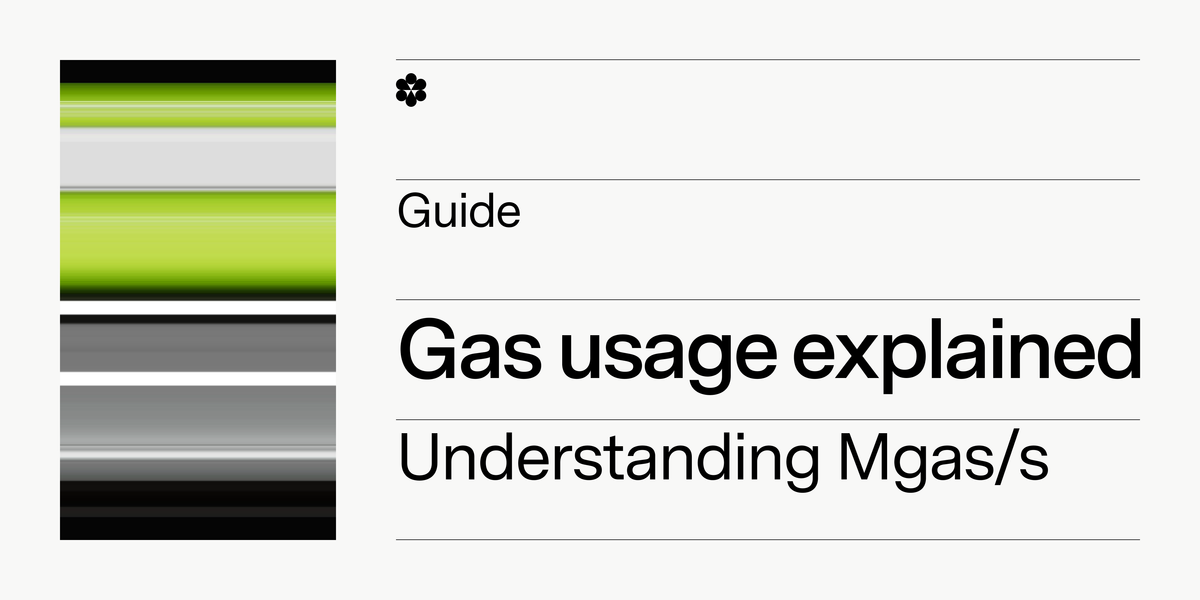Gas Usage for Blockchains: What It Means and Why Mgas/s Is The New Standard For Measuring Onchain Performance
As a direct measure of onchain compute, Mgas/s is the best metric for comparing blockchain performance.

Blockchains are rapidly evolving, which means the metrics we use to evaluate and compare blockchains must evolve as well. Traditionally, transactions per second (TPS) has been the go-to measure of blockchain performance. But with blockchains now supporting more use cases than ever before, individual transactions on different chains and apps are no longer directly comparable, as they represent different actions that put different levels of stress on the chain.
We need a metric that reflects the true throughput and computational power being processed by each chain. That’s what gas usage provides, in the form of megagas per second (Mgas/s). In this blog, we’ll explain what gas usage is and why it’s the best measure of blockchain performance.
Understanding Mgas/s: What does gas usage measure for blockchains?
In the context of Ethereum and L2s built on Ethereum, gas is the unit of measurement that reflects the computational work necessary to carry out any onchain operation, such as a transaction or smart contract interaction. The more complicated the operation, the more gas is required. Validator nodes expend the computational effort represented by gas, and are reimbursed from the gas fees paid by users.
Gas usage per second therefore gives us a snapshot view of how much computational effort a blockchain is processing at any given time. We generally express this measurement as millions of gas units per second, or Mgas/s.
Why Mgas/s is the best performance metric for blockchains
As a direct measure of onchain compute, we believe Mgas/s is the metric the industry should standardize around when comparing the performance of different blockchains and onchain apps.
The shortcomings of TPS
As a measurement of the number of transactions happening per second at any given time, TPS is a straightforward, easy-to-understand measurement of how much activity is happening on a blockchain. But as blockchains have become more complex, and onchain apps serve a wider variety of use cases, TPS is insufficient for comparing the activity and performance of different blockchains. Whereas blockchains once primarily supported simple financial transactions, they now do much more than that:
- Gaming. Teams like Proof of Play, Ancient8, Gold, and others are building dedicated rollups for games.
- Art and entertainment. Teams like Zora and Donatuz are building blockchains for creators to publish and receive payment for original art.
- Social media. Teams like Lens are building onchain social media platforms, with others like Zora expanding their offerings to encompass social as well.
- Web2 consumer competitors. Several teams are building decentralized alternatives to existing web2 apps. For instance, Blackbird is building a decentralized reservations app with its own rewards token. Polymarket has built the world’s largest prediction market onchain. Galxe has built the Gravity Chain for its superapp.
- Ecosystems. Teams like Mode Network have built dedicated blockchains for ecosystems of other apps. Other chains act as an infrastructure component for an ecosystem of apps – for instance, Orderly Network is the settlement layer for several different DEXs.
Individual onchain transactions for each of these use cases mean different things, commit different amounts of data to the blockchain, and require different amounts of computational power. That makes TPS a poor metric for comparing blockchains spanning different use cases.
Gas usage accounts for blockchain differences
While transactions aren’t directly comparable for different blockchains, computational power is. That’s why we advocate for Mgas/s as the best measurement of blockchain performance.
For instance, Proof of Play’s Apex and Boss chains frequently lead all rollups in Mgas/s, despite not leading in TPS.

The reason for this is that Proof of Play’s transactions contain the data for all elements of Pirate Nation gameplay. That makes them uniquely data and compute-intensive. In fact, one transaction for Pirate Nation can require as much as 1 Mgas — nearly 10x the amount of compute required for the average transaction on Ethereum mainnet. Gas usage provides a comparison point for the two chains that TPS can’t, based on computational power.
Gas usage dictates what’s possible to build onchain
Gas usage provides a clearer picture of the real-world demands placed on blockchain infrastructure, which is essential for developers building ambitious and resource-intensive applications.
That’s why we optimize for Mgas/s on the rollups we support at Conduit. By providing a robust platform where high gas throughput is the norm, we empower developers to push the boundaries of what's possible onchain, bringing more complex and feature-rich applications to fruition. Ultimately, a commitment to optimizing for gas usage is key to building a decentralized internet where onchain apps are as powerful and scalable as their centralized counterparts.

